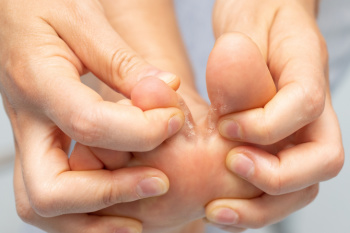
Athlete’s foot can lead to painful blisters that form on the soles of the feet or between the toes. These blisters, often filled with clear or yellowish fluid, may occur even in areas without friction and can become more than just a source of discomfort. When athlete's foot blisters break open, they expose the skin to bacteria, increasing the chance of infection. Signs of a developing bacterial infection may include redness, swelling, pus, or a sensation of warmth in the affected area. In more serious cases, the infection can spread deeper into the foot or affect nearby lymph nodes. These blisters should not be popped, as removing the protective layer increases the risk of complications. Ongoing exposure to moisture and fungi may also lead to repeat infections or allergic reactions, further irritating the skin. A podiatrist can assess blistering caused by athlete’s foot, identify signs of infection, and recommend appropriate treatment. If blisters from an athlete's foot infection are causing problems, it is suggested that you schedule an appointment with a podiatrist for appropriate treatment options.
Athlete’s foot is an inconvenient condition that can be easily reduced with the proper treatment. If you have any concerns about your feet and ankles, contact Joseph Creswell, DPM from Practice. Our practitioner will treat your foot and ankle needs.
Athlete’s Foot: The Sole Story
Athlete's foot, also known as tinea pedis, can be an extremely contagious foot infection. It is commonly contracted in public changing areas and bathrooms, dormitory style living quarters, around locker rooms and public swimming pools, or anywhere your feet often come into contact with other people.
Solutions to Combat Athlete’s Foot
- Hydrate your feet by using lotion
- Exfoliate
- Buff off nails
- Use of anti-fungal products
- Examine your feet and visit your doctor if any suspicious blisters or cuts develop
Athlete’s foot can cause many irritating symptoms such as dry and flaking skin, itching, and redness. Some more severe symptoms can include bleeding and cracked skin, intense itching and burning, and even pain when walking. In the worst cases, Athlete’s foot can cause blistering as well. Speak to your podiatrist for a better understanding of the different causes of Athlete’s foot, as well as help in determining which treatment options are best for you.
If you have any questions please feel free to contact our office located in Wallace, ID . We offer the newest diagnostic and treatment technologies for all your foot and ankle needs.
